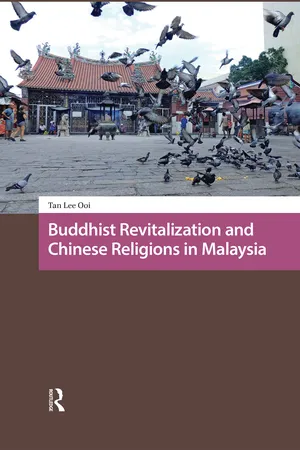
- English
- ePUB (mobile friendly)
- Available on iOS & Android
Buddhist Revitalization and Chinese Religions in Malaysia
About this book
Buddhist Revitalization and Chinese Religions in Malaysia tells the story of how a minority community comes to grips with the challenges of modernity, history, globalization, and cultural assertion in an ever-changing Malaysia. It captures the religious connection, transformation, and tension within a complex traditional belief system in a multi-religious society. In particular, the book revolves around a discussion on the religious revitalization of Chinese Buddhism in modern Malaysia. This Buddhist revitalization movement is intertwined with various forces, such as colonialism, religious transnationalism, and global capitalism. Reformist Buddhists have helped to remake Malaysia's urban-dwelling Chinese community and have provided an exit option in the Malay and Muslim majority nation state. As Malaysia modernizes, there have been increasing efforts by certain segments of the country's ethnic Chinese Buddhist population to separate Buddhism from popular Chinese religions. Nevertheless, these reformist groups face counterforces from traditional Chinese religionists within the context of the cultural complexity of the Chinese belief system.
Frequently asked questions
- Essential is ideal for learners and professionals who enjoy exploring a wide range of subjects. Access the Essential Library with 800,000+ trusted titles and best-sellers across business, personal growth, and the humanities. Includes unlimited reading time and Standard Read Aloud voice.
- Complete: Perfect for advanced learners and researchers needing full, unrestricted access. Unlock 1.4M+ books across hundreds of subjects, including academic and specialized titles. The Complete Plan also includes advanced features like Premium Read Aloud and Research Assistant.
Please note we cannot support devices running on iOS 13 and Android 7 or earlier. Learn more about using the app.
Information
Table of contents
- Cover
- Half Title
- Title
- Copyright
- Table of Contents
- List of Tables
- Abbreviations
- List of Chinese Characters
- Orthography
- 1 Introduction
- 2 A Brief History of Buddhist Transnational Connections
- 3 Reforming Chinese Buddhism through the Zheng Xin (Right Faith) Movement
- 4 New Transnational Connections with Taiwan
- 5 Remaking Chinese Buddhists
- 6 Counterforces of Buddhist Revitalization
- 7 Conclusion
- Appendices
- Bibliography
- Index